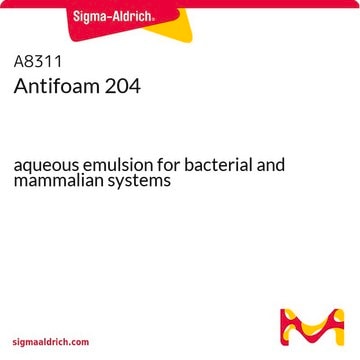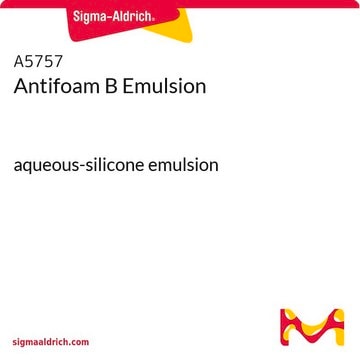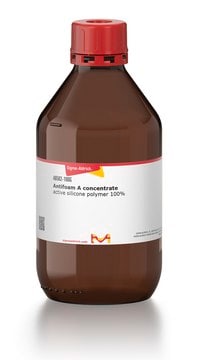A6426
Antiespumante 204
mixture of organic polyether dispersions
Sinónimos:
organic antifoam
Iniciar sesiónpara Ver la Fijación de precios por contrato y de la organización
About This Item
Productos recomendados
origen biológico
synthetic
Formulario
liquid
técnicas
microbiological culture: suitable
viscosidad
400 cP(lit.)
densidad
1.01 g/cm3 at 25 °C (lit.)
temp. de almacenamiento
room temp
¿Está buscando productos similares? Visita Guía de comparación de productos
Categorías relacionadas
Descripción general
Función antiespumante como un efectivo supresor de espuma. El antiespumante 204 contiene componentes activos al 100 % y es una mezcla de dispersiones orgánicas de poliéter basadas en polipropileno sin silicona. No contiene aceite mineral. El antiespumante 204 puede ser considerado como un tensioactivo, pero no contiene otros tensioactivos. Este producto es sintético y no procede de fuentes de origen animal o vegetal. El antiespumante 204 puede esterilizarse repetidamente. Las propiedades de flujo del antiespumante 204 son tales que puede ser bombeado hasta un fermentador según necesidad. Para utilizar en medios microbiológicos, Sigma recomienda una concentración de partida comprendida entre el 0,005% y el 0,01%.
Aplicación
El antiespumante 204 se ha utilizado:
- para suprimir la formación de burbujas en disoluciones de tilacoides durante la cuantificación del isopreno intramembranario
- como componente del medio de cultivo semicontinuo (lote alimentado) para fermentación
- para suprimir una intensa formación de espuma en el fermentador
Características y beneficios
- Tensioactivo muy versátil para su investigación en biología celular y bioquímica
- Adecuado para cultivo microbiológico
Otras notas
Contiene componentes activos al 100 % y es una mezcla de antiespumantes orgánicos distintos de la silicona en una dispersión poliol. Puede esterilizarse repetidamente.
Si desea más información sobre nuestra gama de productos bioquímicos, cumplimente este formulario.
Código de clase de almacenamiento
10 - Combustible liquids
Clase de riesgo para el agua (WGK)
WGK 3
Punto de inflamabilidad (°F)
Not applicable
Punto de inflamabilidad (°C)
Not applicable
Elija entre una de las versiones más recientes:
¿Ya tiene este producto?
Encuentre la documentación para los productos que ha comprado recientemente en la Biblioteca de documentos.
Los clientes también vieron
Juan J Barrero et al.
New biotechnology, 60, 85-95 (2020-10-13)
Pichia pastoris (Komagataella spp.) has become one of the most important host organisms for production of heterologous proteins of biotechnological interest, many of them extracellular. The protein secretion pathway has been recognized as a limiting process in which many roadblocks
Vasil D'Ambrosio et al.
Metabolic engineering, 61, 369-380 (2020-07-28)
Engineering living cells for production of chemicals, enzymes and therapeutics can burden cells due to use of limited native co-factor availability and/or expression burdens, totalling a fitness deficit compared to parental cells encoded through long evolutionary trajectories to maximise fitness.
Martin Kavšček et al.
BMC systems biology, 9, 72-72 (2015-10-28)
Yarrowia lipolytica is a non-conventional yeast that is extensively investigated for its ability to excrete citrate or to accumulate large amounts of storage lipids, which is of great significance for single cell oil production. Both traits are thus of interest
Ultrasound-assisted fermentation enhances bioethanol productivity
Sulaiman AZ, et al.
Biochemical Engineering Journal, 54(3), 141-150 (2011)
Physiology of Aspergillus niger in oxygen-limited continuous cultures: Influence of aeration, carbon source concentration and dilution rate
Diano A, et al.
Biotechnology and Bioengineering, 103(5), 956-965 (2009)
Nuestro equipo de científicos tiene experiencia en todas las áreas de investigación: Ciencias de la vida, Ciencia de los materiales, Síntesis química, Cromatografía, Analítica y muchas otras.
Póngase en contacto con el Servicio técnico









